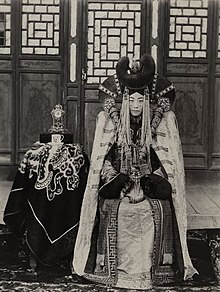Khalkha Mongols

The Khalkha, or Halh (Classical Mongolian: qalq-a, Khalkha Mongolian Халх [χɑɬχ]) are a subgroup of the Mongols. They comprise the majority of the population of the independent state of Mongolia. The standard language of Mongolia is based on the Khalkha dialect.
History

The first reference to the Khalkha people is of the early 16th century. It is widely supported that they got the name from the Khalkha River (qalq-a-yin γoul, Халхын гол) in the far east of Mongolia since they originally lived along it.
Under Dayan Khan, the Khalkha were organized as one of three tümen of the Left Wing. Dayan Khan installed the fifth son Alchu Bolad and the eleventh son Geresenje on the Khalkha. The former became the founder of the Five Khalkha (tabun otuγ qalq-a) of Southern Mongolia and the latter became the founder of the Seven Khalkha (doluγan otuγ qalq-a) of the Northern Mongolia. They were called Inner Khalkha and Outer Khalkha respectively, by the Manchus.

Mongolian chronicles called Geresenje as "Khong Tayiji of the Jalayir," which indicates that the core part of the Khalkha were descendants of the Jalayir tribe. By extension, some scholars consider that the Khalkha had a close connection with the Five Ulus of the Left Wing of the former Yuan Dynasty, which was led by the five powerful tribes of Jalayir, Onggirat, Ikires, Uruud and Mangghud.
The Five Khalkha consisted of five tribes called Jarud, Baarin, Onggirat, Bayaud and Öjiyed. They lived around the Shira Mören valley east of the Greater Khingan. They clashed with but were eventually conquered by the rising Manchus. The Five Khalkha except for the Jarud and the Baarin were organized into the Eight Banners. Note that Khalkha Left Banner of Juu Uda League and Khalkha Right Banner of Ulaanchab League were offshoots of the Seven Khalkha.
The Seven Khalkha expanded into central Mongolia by absorbing the Uriankhai, who rebelled after Dayan Khan's death. They were involved in regular fights against the Oyirad in the west. Geresenje's descendants formed the houses of Zasagt Khan, Tüsheet Khan and Setsen Khan. They preserved their independence until they had to seek help from the Kangxi Emperor of the Manchu Qing Dynasty against the Dzungar leader Galdan in 1688. In 1725 the Yongzheng Emperor gave Tsering independence from the house of Tüsheet Khan, forming the Sain Noyon Khan Aimag.
The Khalkha led the Mongolian independence movement in the 20th century. After enduring countless hardships, they established the independent state of Mongolia in northern Mongolia.
References
- Morikawa Tetsuo 森川哲雄: Haruha Tumen to Sono Seiritsu ni Tsuite ハルハ・トゥメンとその成立について, Tōyō Gakuhō 東洋学報 Vol. 55, No. 2, pp. 32–63, 1972.
- Okada Hidehiro 岡田英弘: Dayan Hān no Rokumanko no Kigen ダヤン・ハーンの六万戸の起源, Enoki Hakushi Kanreki Kinen Tōyōshi Ronsō 榎博士還暦記念東洋史論叢, pp. 127–137, 1975.
